One of the things I love most about pitching is that small adjustments can completely change a pitcher. A new pitch, an adjustment in mechanics, anything, and suddenly a mediocre or good pitcher becomes a great one.
In fact, that’s one of the driving forces behind TINSTAAPP, a term coined over a decade ago by Baseball Prospectus founder Gary Huckabay that stands for “There Is No Such Thing As A Pitching Prospect,” which essentially posits that teams shouldn’t over-invest in young pitching prospects because of how volatile the position is. We see great pitching prospects bomb and we see 12th-rounders turn into aces.
Now, TINSTAAPP certainly has its problems, but the idea that small adjustments can completely change a pitcher’s career is very true. As fantasy baseball analysts and players, we’re always looking for guys who have made positive changes so we can get in on the ground floor and have that player on our team before they blow up. One of those changes you hear about frequently is a change in arm slot. Pitchers will sometimes make adjustments to the angle at which they throw the ball, and sometimes that can completely change a pitcher.
So naturally, whenever there’s a story of a pitcher changing his arm slot, fantasy analysts tend to jump all over it, thinking it might be the key to a pitcher having success. But just how much does a pitcher’s arm slot matter? Do certain arm slots correlate with better outcomes for pitchers? Do certain arm slots correlate with higher pitcher velocity? More strikeouts? Fewer walks? And how important is it when a pitcher changes their arm angle?
That’s what I’d like to find out.
Are some arm slots better than others?
First thing I want to do is give credit to the inspiration for this piece and also the source of the dataset that I’m using, and that’s Logan Mottley at Rundown Baseball. Mottley wrote a piece asking a lot of the questions I’d like to answer about arm slot, and in that piece, he compiled a ton of data on pitchers’ arm slots over the years. If you want to dive into the weeds of exactly how he calculated everything, definitely check out his piece (hope you like math!); there’s a ton that went into his work and I’m grateful for it. In short, Mottley was able to give us every pitcher’s average arm angle from 2015 through 2020.
Using that dataset, I want to answer some of the questions mentioned above. With the help of our own Justin Filteau, who is wonderful and significantly smarter than me, we took Mottley’s arm angle data, broke it down by pitch, and looked to see if it correlated with a variety of different stats.
First question: Do certain arm slots correlate with higher pitch velocity? That is, if a pitcher throws from a higher or lower angle with their fastball, does it make them more likely to throw harder?
Here’s what we found (and for reference on this graph—an arm angle approaching zero is an extremely high up arm angle):
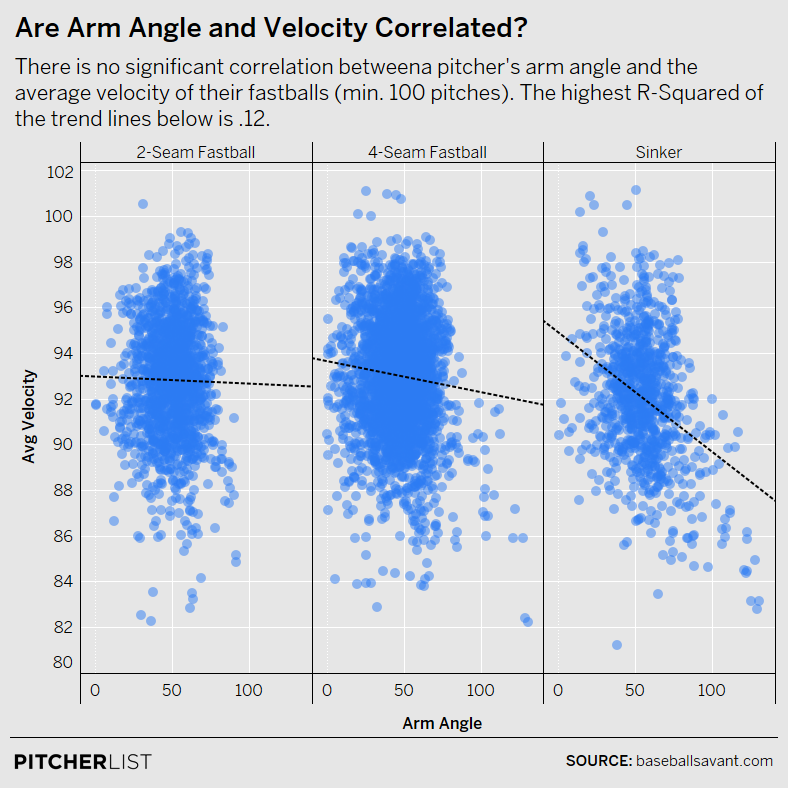
Data Visualization by @Kollauf on Twitter
The answer to that appears to be a resounding no—arm angle doesn’t correlate to higher or lower fastball velocity.
Next question: Do certain arm slots correlate with better strikeout or walk rates? It seems reasonable to think that certain arm slots may be more deceptive than others, leading more batters to strike out. Or, the opposite, some arm slots may be less deceptive, meaning fewer strikeouts because batters have a better idea of what’s coming. And perhaps some arm angles help pitchers control their pitches better so walk rates are lower?
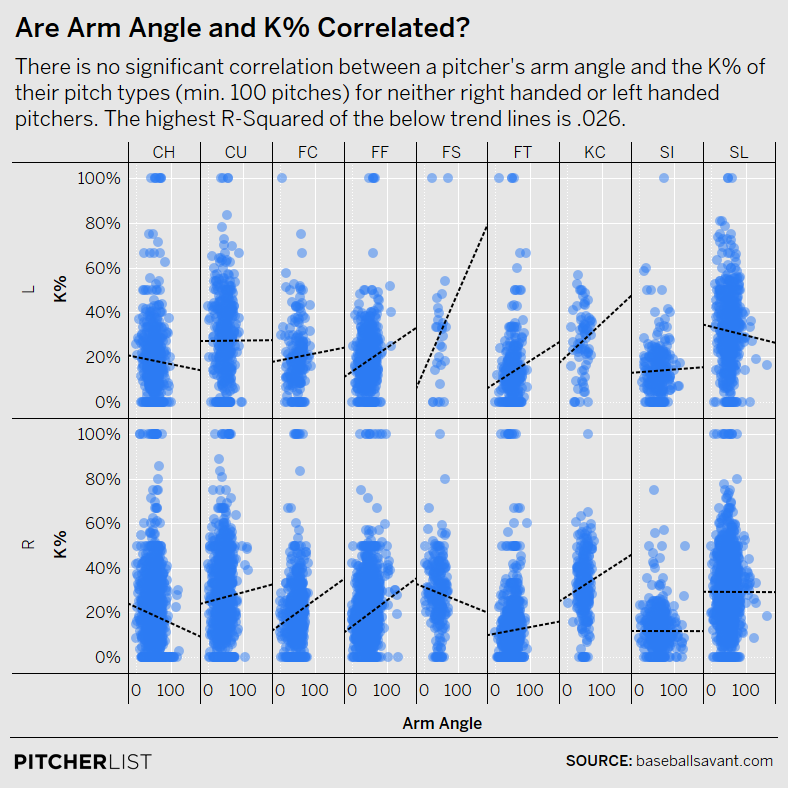
Data Visualization by @Kollauf on Twitter
The answer for strikeout rate? Nope.
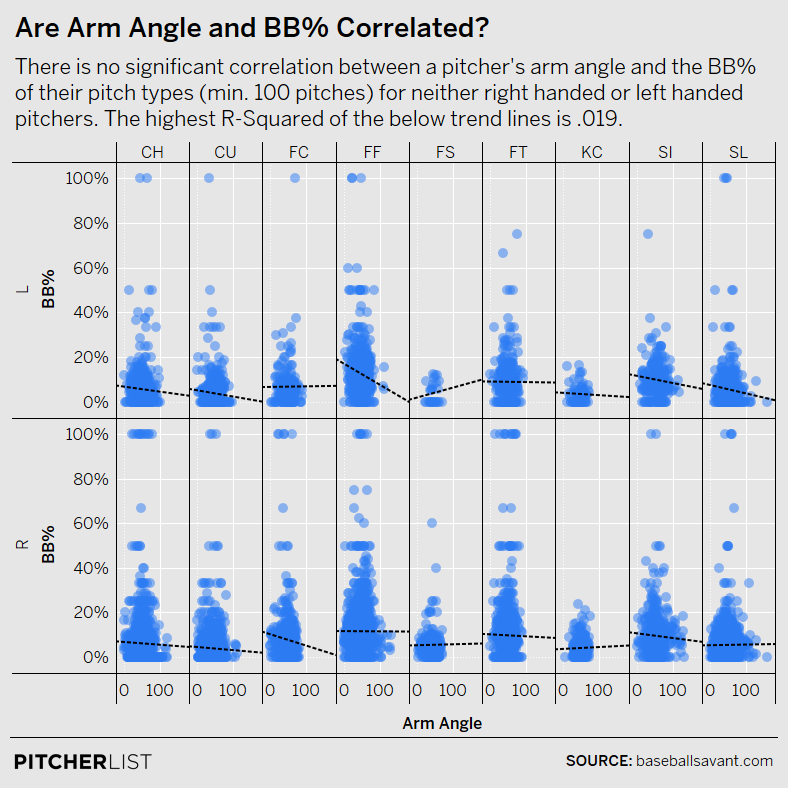
Data Visualization by @Kollauf on Twitter
The answer for walk rate? Also, no. There doesn’t seem to be any correlation between arm slot and either strikeout rate or walk rate.
How much does it matter when a pitcher changes their arm slot?
So we know now that there aren’t really any specific arm slots that correlate with better outcomes, but a pitcher changing their arm slot isn’t entirely about getting specific outcomes. In fact, it can often be part of a broader change in mechanics. So the next question I want to answer is, how much does it matter when pitchers change their arm slot?
To figure this out, we took the arm angle data, looked at arm angle density plots for each individual pitcher’s pitch type, and used pitchers who had two very distinct peaks, suggesting a significant change in arm slot. Here’s an example of data we used—Jalen Beeks‘ cutter—versus an example of the data we didn’t use—Jacob deGrom’s four-seam fastball:
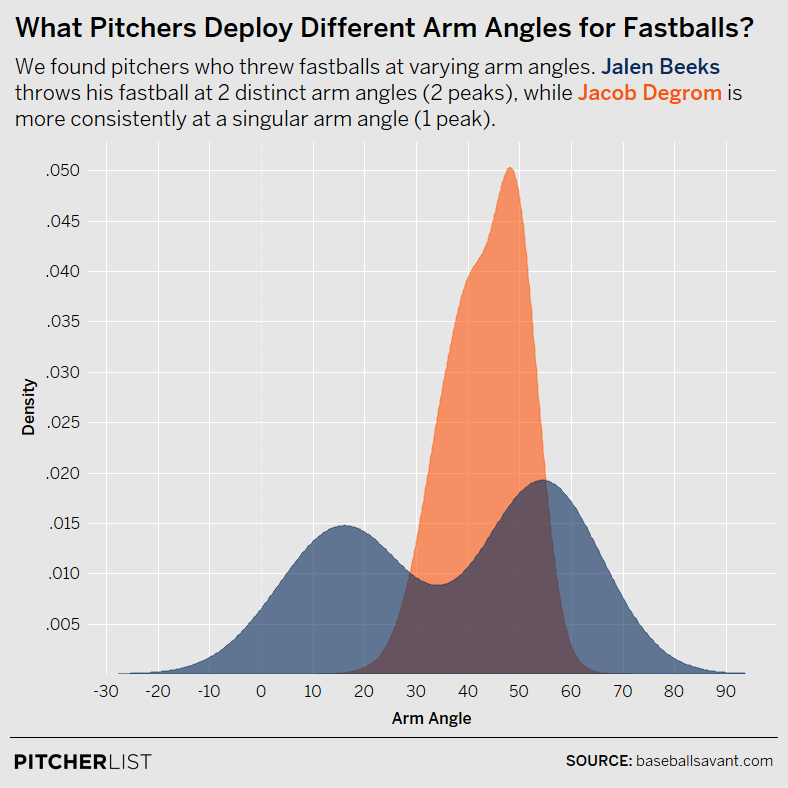
Data Visualization by @Kollauf on Twitter
In Beeks’ graph, you can clearly see two different peaks, but in deGrom’s, while there’s a slight secondary bump, it’s not enough to suggest a significant change in arm angle.
Then, we took the lowest point in the downward curve between the two peaks, set that as the minimum value where the pitches were split into two arm angle groups, computed strikeout rate, walk rate, and whiff rate for each of those groups, and noted the differences between them. Here’s a box plot of what we found with regards to strikeout rate:
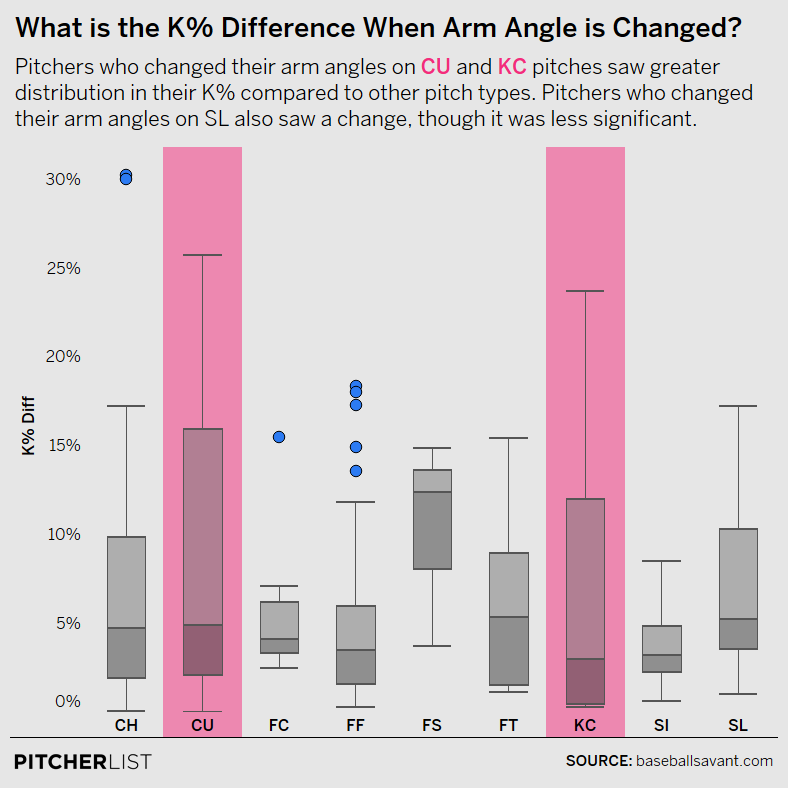
Data Visualization by @Kollauf on Twitter
For reference, the pitch types whose boxes shift further to the top are those in which pitchers saw bigger differences in their strikeout rates between their different arm angles.
What we found was pitchers who changed their arm angles on the curveballs saw a big change in their strikeout rate (this was true for both regular curveballs and knuckle curveballs). Pitchers who changed their arm angle on sliders also saw a notable change, though less significant than changes in curveballs.
Now, it’s important to note that this doesn’t mean there’s a correlation between arm angle and strikeout rate for curveballs and sliders. We mentioned earlier how we didn’t find that correlation. Instead, what we found was when a pitcher changed their arm slot, regardless of what they changed the arm slot to or where the arm slot was prior, they typically saw a jump in strikeout rate with their curveball and to a lesser extent, their slider. This was especially the case when they raised their arm slot higher than they had it before.
So what does this all mean?
We’ve just gone through a lot of data, and honestly, I wouldn’t blame you if you were a little confused. Frankly, this data took me a long time to kind of digest and sort through. So ultimately, what does this all mean? The question in the headline is, how much should we care about pitchers’ arm slot, so how much then?
The answer is a little tricky and it’s probably going to be a little unsatisfying, but sometimes, data is exactly that—unsatisfying. When I started this article, what I really wanted was the data to show one of two things—either certain arm slots/changing arm slots correlate to better outcomes for pitchers or they don’t at all. But instead, the data gives us a little bit of both. There doesn’t appear to be a specific arm slot for any specific type of pitch that really correlates to better strikeout rates or better walk rates. But, it does seem that when pitchers change their arm slots, they often improve at least their curveballs when they raise their arm slot a bit higher (and to a lesser extent, their sliders). And if you think specifically about curveballs, I think that makes sense. I mentioned this data to Rob Friedman (PitchingNinja on Twitter, in case you’re not familiar) and he told me that often pitchers say throwing a curveball more north/south in delivery is better because you have a better chance of missing the bat. The bat is long, but it’s only so wide.
We’ve also seen an example of a pitcher toying with their arm slot and seeing positive results across their repertoire as a result this year—Jose Berrios. At the end of last year and in the offseason, Berrios started toying with his arm angle, raising it to more of an overhead delivery rather than a three-quarters delivery. As a result, Berrios saw two things happen: His curveball started getting more vertical drop than it had in the past, and his spin rate on his four-seam fastball increased. As of this writing, Berrios is looking at a career-best 3.45 ERA with a 3.57 FIP. Is his change in arm angle the reason for his success? I’d say it’s likely part of it (that, and a much-improved sinker).
Either way, the main takeaway for me is that when you hear about a pitcher changing their arm slot, pay attention to it, but don’t take it as a guarantee the guy has things figured out and is suddenly going to have a breakout season. We fantasy analysts often make a big deal out of changes like that, and understandably so. As I mentioned earlier in the article, we’ve seen pitchers shoot up from mediocrity to stardom in part because they made adjustments to their arm slot. This kind of a change can be a sign that a pitcher is toying with their mechanics, and as we’ve seen in the past, that can be a game-changer.
Bare minimum, a pitcher changing their arm slot is worth paying attention to, but life rarely has any guarantees, and this isn’t one of them.
Photo by Tj Kolesnik/Unsplash | Adapted by Ethan Kaplan (@DJFreddie10 on Twitter and @EthanMKaplanImages on Instagram)


Appreciated the analysis! Although not part of the data studied, might changing arm slots also affect injury risk and career longetivity for certain pitchers? As fans watching the games, sometimes we hear concern that a pitcher with an unorthodox delivery may carry more injury risk than one with a more conventional arm slot.
That’s an excellent question! I’ll have to look into that data – might be worth a whole other article if there’s a correlation between arm slot and injury risk
Thanks! If it helps with the research, I recall former pitcher Mike Krukow on the Giants’ broadcast recently discussing Lucas Giolito’s arm slot change in the context of shorter term effectiveness versus career longevity. If I remember correctly, Krukow believed that his similar mechanical change in arm slot (a short arm delivery?) may have lessened his career longevity from a health standpoint.